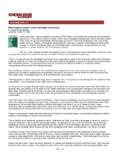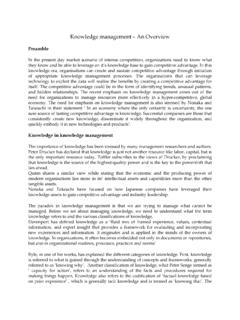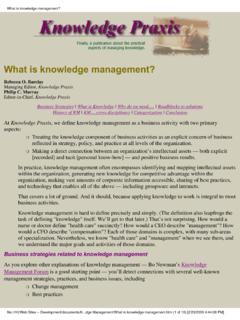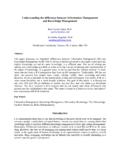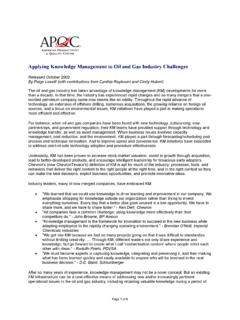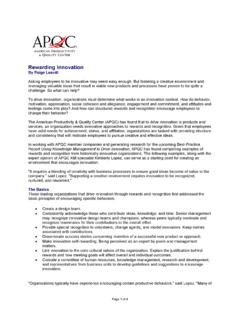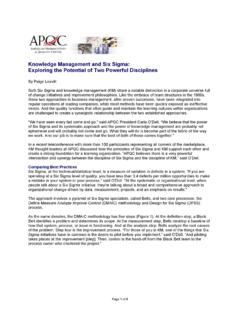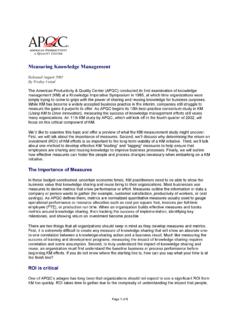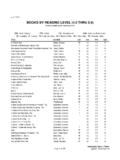Transcription of Storytelling in Organizations: The power and traps of ...
1 1 Storytelling in Organizations: The power and traps of using stories to share knowledge in organizations Deborah Sole, LILA Harvard University Daniel Gray Wilson, LILA Harvard University Sharing experiences through stories is emerging in various professions as a powerful way to exchange and consolidate knowledge. Research suggests that sharing experiences though narrative builds trust, cultivates norms, transfers tacit knowledge, facilitates unlearning, and generates emotional connections. This brief aims to look closely at the power of Storytelling and compare it to other ways knowledge can be exchanged in organizations.
2 This brief argues that successful use of stories hinges on choosing the appropriate story-moments and being clear on the knowledge sharing goals. In conclusion, the authors share suggestions from the literature on how to best design, tell and listen to stories in knowledge-sharing situations in organizations. Introduction Over coffee, Janet explains to her colleague how she saw their disagreement in yesterday s meeting. In the boardroom, a CEO shares a vision of what the organization will look like in the future. In the elevator, a manager tells a funny anecdote to a group of friends about how he handled a difficult client.
3 Each of these scenes reveals the prevalence of stories in our lives. We all continuously create and share stories of what happened, why, and what might happen next replete with a cast of characters, multiple plots and drama (Bruner, 1992; Weick, 1979). Individually and collectively, stories help us make sense of our past and understand possible futures. Storytelling is traditional and even ancient means of passing on wisdom and culture. Yet in organizations particularly business organizations what is most explicitly valued are harder forms of knowledge that can be classified, categorized, calculated and analyzed.
4 In recent years, however, there has been increasing attention by organizations and their leaders to the role and value of narrative and anecdotal information conveyed in the form of stories. This renewed interest in an ancient genre of communication is perhaps a result of the realization of the importance of knowledge in organizations and the recognition that knowledge cannot be completely abstracted into categorical and analytical forms and is inadequately conveyed in such forms. Instead, organizations seek communicative forms that synthesize rather than analyze.
5 Stories are such a communicative form. In recent meetings, LILA members have echoed this sentiment. Last July Mike Thalacker shared how Johnson&Johnson is creating an online database full of employee stories. In September SAIC s Peter Engstrom described their approach to capturing knowledge through gathering stories. In these meetings, LILA members raised questions 2 such as, How are stories best used to create collective vision? How do stories build and/or renew trust? How are stories best used to transfer prized tacit knowledge?
6 With this background in mind, this brief will explore the power of Storytelling in organizations, focusing in particular on how Storytelling can be a mechanism for sharing knowledge within organizations. The brief first reviews some of the theoretical and empirical benefits of Storytelling in organizational contexts. Subsequently, it provides a brief definition of the kind of story that is suitable for our purpose of sharing knowledge. Next, it presents an analysis comparing and contrasting Storytelling with other knowledge sharing strategies.
7 Finally, it summarizes some suggestions regarding what makes a good story and suggests when and how the use of stories may be valuable. The power of Stories Most of us are familiar with the story of copier repair technicians tech reps at Xerox, whose activities challenged the conventional wisdom of the Industrial Age: It begins in the 1980s. Looking for ways to boost the productivity of the Xerox field service staff, Xerox launched a study of their work before deciding how to proceed. An anthropologist traveled with a group of tech reps to observe how they actually did their jobs -- not how they described what they did, or what their managers assumed they did.
8 The anthropologist saw that tech reps often made it a point to spend time not with customers but with each other. They'd gather in common areas, like the local parts warehouse, hang around the coffee pot, and swap stories from the field. Whereas a reengineer would see this behavior as unproductive and to be eliminated, the anthropologist saw the exact opposite. The tech reps weren't slacking off; they were doing some of their most valuable work. Field service, it turns out, is a social activity involving a community of professionals.
9 The tech reps weren't just repairing machines; they were also coproducing insights about how to repair machines better. This discovery triggered a revolutionary change in how Xerox organized and managed the tech reps no longer as independent workers but as a social learning unit. (Brown & Gray, 1995) This story sparked startling new insights into the social nature of work and knowledge. Interestingly, through its telling and retelling to other companies, this story has prompted something of a revolution in management principles more suitable for the Knowledge Era.
10 Those of us with even a passing interest in sports have probably heard the story of the New England Patriots long road to becoming Super Bowl champions. No team in the National Football League has as zany a history of miscreants and missteps as the Patriots, but that February Sunday in the Superdome every ghost was exorcised from their star-crossed history. With one fiery night of passion and victory, the Patriots rewrote their story .. In one of the most exciting Super Bowl finishes ever, the kicker booted home a 48-yard field goal with no time left on the clock to give his team of no-name warriors a 20-17 Super Bowl win.
